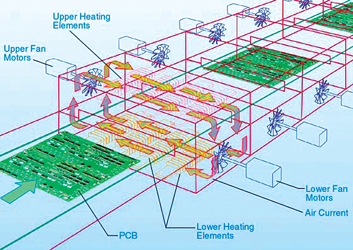
Leading up to the development of lead-free soldering alloys, Novastar developed ‘horizontal convection’ for the soldering reflow process. Novastar has pioneered innovations such as baffle-free solder pots, high efficiency preheaters, exchangeable heater technology, efficient low cost forced-air systems and now, its horizontal convection reflow oven technology can deal with the precise profiles required by lead-free solders.
Getting the correct temperature profile, with the narrow process window in lead-free applications is now more important than ever. In each chamber or 'zone', air is circulated toward one side of the oven above the PCB and toward the opposite side of the oven below the PCB, forming a 'cyclone' around the board (Figures 1 and 2). This forced air circulation results in a uniform temperature profile along the entire circuit board assembly. This technology is ideal for the precise profiles needed for lead-free soldering.


Horizontal convection defined
* The main difference between horizontal convection and traditional oven technology:
In traditional reflow ovens, air currents are introduced vertically from above and below on the PCB while in horizontal convection, air is circulated horizontally in one direction across the top of the board and in the opposite direction beneath the board. This is key. This prevents hot spots and because of this parallel 'angle of attack' the air stream's ability to infiltrate the spaces underneath component bodies such as BGAs and J-leaded devices is enhanced. Temperatures across the entire PCB front to back are thus virtually identical (Figure 3).

* Lower overall equipment cost and operation cost:
Because the horizontal convection system requires neither plenum nor air re-introduction apparatuses, it is (due to its simplicity) more reliable and less costly. There is no need for costly flux management systems as there is no sticky flux residue in the oven. This greatly reduces the need for constant cleaning, maintenance and servicing.
* Eliminates hot spots across the board:
By controlling the air flow around the board by having consistent temperature, air pressure, air velocity, volume and direction across the board, temperature uniformity is ensured. The top and bottom of the board receive the air from the outsides toward the centre, which acts to counter the centre hot-spot/cool-outside condition (Figure 3). This minimises thermal stress to PCB materials and components.
* No flux management system is needed:
There is no flux residue because the air is recirculated within the confines of each chamber. Chambers each contain all the elements needed to be self-sufficient: heating elements, fan blades, inert gas suffusers and exhaust ports. The air never comes into contact with cooler surfaces and thus does not condense anywhere within the oven.
* Uses less nitrogen in inert atmosphere applications:
An advantageous side-effect of the system is an ability to produce low oxygen ppm (parts per million) levels when purging with inert gas, because the volume of space to be affected includes only the confines of each chamber. In traditional oven design, by contrast, the chamber as well as the upper and lower plenums must be purged.
* The best profiles!
There are multiple reasons for this claim. Heated air within each zone is extremely controllable and precise. Temperatures across the board are uniform with no hot spots because air is circulated horizontally in a circular or 'cyclone' motion around the PCB. Temperatures across the entire PCB front to back are virtually identical.
| Tel: | +27 11 704 6677 |
| Email: | [email protected] |
| www: | www.testandrework.co.za |
| Articles: | More information and articles about Test & Rework Solutions |
© Technews Publishing (Pty) Ltd | All Rights Reserved